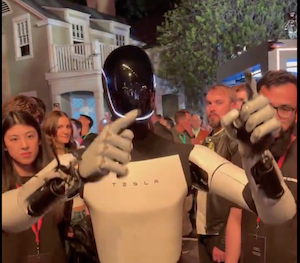This is honestly so cool. pic.twitter.com/Uf67zpuG0Q
— Ian Miles Cheong (@stillgray) October 11, 2024
In the ever-evolving saga of Elon Musk’s ventures, Tesla’s Optimus robot stands out as a blend of science fiction becoming reality. Announced with grand visions at Tesla’s AI Day, Optimus has been progressing from a concept to, well, a robot that can now walk around without looking like it’s about to tip over.
Optimus Gen 2 has been showcased with significant improvements. It’s lighter, faster, and boasts an array of new capabilities like better hand dexterity and object manipulation. Elon Musk, ever the optimist, shared new footage at Tesla’s shareholder meeting, demonstrating Optimus not just walking but working in Tesla’s factory, hinting at a future where these robots might not just assist but significantly boost productivity.
NEW: Elon Musk introduces an army of Optimus robots, says people will be able to buy them to complete tasks.
— Collin Rugg (@CollinRugg) October 11, 2024
Epic.
Musk then said attendees could walk up to the Optimus robots who would do things like serve drinks.
"At scale, you should be able to buy an Optimus robot for… pic.twitter.com/zsGF4zzhaR
The latest updates suggest Optimus will undergo another upgrade by year’s end, aiming for limited production in Tesla’s facilities by 2025. Musk’s vision for Optimus isn’t just about making robots; it’s about creating companions in work and potentially in life, with the robot learning tasks by watching videos or being instructed verbally.
This ambition, while exciting, stirs up a mix of awe and skepticism. Critics and tech observers have their doubts, pointing out the gap between demo videos and real-world application, questioning the practicality of humanoid robots over specialized machinery. Yet, Musk’s track record with Tesla vehicles and SpaceX missions gives Optimus a glimmer of credibility, or at least a spectacle worth watching.
The journey of Optimus reflects Musk’s broader philosophy: pushing boundaries, not just for the sake of innovation but for transforming how we live and work. Whether Optimus will become as ubiquitous as smartphones or remain a niche marvel in robotics labs, the project represents a bold step into a future where AI and robotics might just become our daily companions, talking, working, and perhaps, in the spirit of Musk’s humor, even joking with us.
Here is the next-generation Tesla Bot (Optimus) hand with 22 degrees of freedom. It looks remarkably human like.
— Sawyer Merritt (@SawyerMerritt) October 11, 2024
The previous version had 11 degrees of freedom. pic.twitter.com/3fXyIa5VTq
